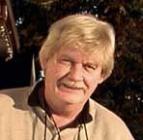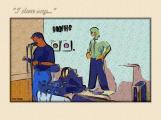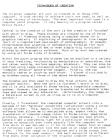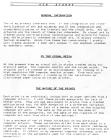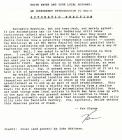1
Ken Stange, an only child, was born in 1946 in Chicago, Illinois, as Kenneth Richard Stange. He was raised in Chicago.From 1964 to 1968, he earned a Bachelor of Science in Psychology at Loyola University in Chicago.
In 1966, he married Ursula Stange, with whom he has two children.
In 1968, Ken and Ursula moved to Toronto, Ontario, where he worked until 1971 as a research assistant in the physiological psychology laboratory at the University of Toronto. In 1971, they moved to North Bay, Ontario, where they currently reside. From 1971 to 1992, he was an instructor in the department of psychology at Nipissing University, and in 1992, he became a tenured lecturer in the department.
He served on the Board of Directors of White Water Gallery in North Bay intermittently from 1978 to 2005, including a term as president from 1989 to 1990.
Solo exhibitions of his work include: Oh Henry! Oh My Gawd (2004, White Water Gallery, North Bay), Retrofactals (1993, The Muse, North Bay), Computer Poet-Tree Sculpture (1991, White Water Gallery, North Bay), Take Frequent Snapshots (1991, Galerie 211, École Algonquin Public Gallery, North Bay), and Portraits (1988, White Water Gallery, North Bay).
He wrote a biweekly arts column for The North Bay Independent from the spring of 1990 to the spring of 1990, and a weekly arts column for the North Bay Nugget from the spring of 1990 to the end of 1991.
He is a published poet and writer. He is the founder, editor and publisher of Nebula Netzine (1995 to present; http//KenStange.com/nebula/) as well as Nebula magazine (1975-1983), a literary quarterly funded by the Canada Council for the Arts and the Ontario Arts Council
He received Ontario Arts Council writing grants in 1976, 1977, 1980, 1981, 1983 and 1986.
Ken's works are in private, corporate and public collections, including the Capitol Centre (North Bay), North Bay City Hall, and Ontario Northland Railway.
(The biographical information featured here was written in consultation with the artist in 2006.)
Interview:
Q: Do you have an earliest memory of being interested in art, and if so, what is it?
A: Depends whether you mean "art" in the broad sense or visual art. My first passion was literature. From when I was just a toddler, my mother would read to me, with me watching over her shoulder, and from this I figured out how to decode those black and white thingies on the page. So I was reading well before starting school. Since we had virtually no books in the house, the public library became my favourite haunt. And it is probably this that first led me indirectly to an interest in visual art. We lived in a working class neighbourhood on the south side of Chicago, and the local branch library was rather limited in its offerings, so-my mother being very tolerant-permitted me, from a very early age, to take the somewhat 'sketchy' Chicago El ("the elevated"; the Chicago "subway" was largely above ground) downtown to the main branch, which was huge. It was a few blocks away from The Art Institute of Chicago, which is one of the world's great galleries. It--and The Shedd Aquarium, The Museum of Natural History, and the Adler Planetarium-are all within walking distance of each other. Naturally enough I repeatedly explored these places while downtown picking up my week's supply of reading material. The Art Institute has one of the best collections of Impressionism outside of Paris, and it also has an extensive and wonderful Modern Art section. I don't know exactly how old I was, but I remember just sitting in one or the other of these gallery rooms, just staring at the works-and daydreaming. It is so different from the way I now, too often, visit galleries and museums, for then I didn't feel I had to see everything in the limited time available. Then I had all the time in the world, time to just sit and give an artwork the time it deserved. (For some reason, I particularly remember staring endlessly at Seurat's A Sunday on La Grande Jatte and being blown away by their collection of Magritte's works.) To this day, when traveling (which I do a lot) and feeling a bit homesick or disoriented, I find emotional comfort, a feeling of being home, in going to a museum or gallery. Anyway, I think we tend to underestimate the importance of galleries, museums and such in the potential they have to engage young minds.
Q: When did you first feel like an artist?
A: Frankly, I still don't--at least in most ways. Even as a writer with half a dozen books, I don't--at least not somewhere deep inside. Hell, I don't even feel really grown-up! And when I'm lecturing to a class of several hundred students, every once in a while I think: "What am I doing here? Where's the real Prof?" This isn't false humility. It's probably just insecurity. But from what I've read, and from people I've talked to, this feeling isn't uncommon. I will say, however, that often one's willingness to lay claim to any role or competence is dependent on some external validation. At least it was for me. I only had the presumption to call myself a poet after my first poem was accepted for publication accompanied by a (very modest) cheque. And as far as claiming status as a visual artist, it waited until my first juried show. I'm sure this isn't true of every artist or writer, but it does point to the importance of there being independent venues for the arts--be they periodicals or galleries--for the artist's own sense of having a legitimate vocation. I can only wonder at those artists, such as Van Gogh, who received no external validation of what they were, their identity--and yet never doubted it. But then of course Van Gogh did eventually kill himself.
Q: You've been very vocal in the North Bay arts community, particularly through published columns, and you tend to state things for what they are. I wouldn't say you are prone to sugarcoating situations. Did you find the community to be reactive at times?
A: Yes! And I'm glad, very glad for any reaction, for the worst possible response for any artist in any medium is a shrug. However, temperamentally, I'm not at all a confrontational kind of guy, and my general attitude towards others is "live and let live". But I do expect the same: don't mess with my freedoms because of your personal agenda! Certainly, if the Emperor isn't wearing any clothes, I'll mention it. And if something is obviously bullshit, I'll remark on the smell in the room. Honesty may offend some people, but only the politically 'correct' and religiously fanatic think 'offending' should be made a criminal offence. When I wrote the arts/alternatives column for the North Bay Nugget, I did everything in my power to promote the arts and the life of the mind. Inevitably, I also indulged in some satirizing of those opposed to freedom of expression, so essential to civilization, be it art or science--or even strip clubs. I admit to having a problem with people who have, to use a phrase I am fond of--my wife says too fond of---people who have "a pickle up their ass." These people are dangerous. It amazes and appalls me that there are so many--and very vocal and pushy--people who sanctimoniously feel the right to impose their personal political or religious dogmas on everyone else. The cornerstone of civilization, what makes both art and science possible, is freedom of expression. Probably most of the scientists and artists who have created our civilization 'offended' church, state, or the general population-and were persecuted for doing so. This is not a good thing. I am apolitical. I belong to no political organizations, but I have belonged to PEN and Amnesty International for a very long time because both have no political agenda, but both work to defend basic human rights (the right to life, protection from torture, and freedom of expression)-whether that threat comes from the right or the left of the political spectrum, from fundamentalist Muslims or Christians, or from the well-intentioned or the malevolent. If anything will destroy civilization, it is certainly not a new scientific truth, no matter how unsavoury to our sense of self-esteem, nor a work of art, no matter how offensive to our current sensibilities. It will be those who wish to gag artists and scientists. Sorry. Off my soapbox now.
Q: Does your professional interest in psychology impact your visual art?
A: Inevitably, but only indirectly. My interest in science is integral to my art, just as is my interest in writing. Science is as important as art. Both are paths to apprehending reality--which is the central theme of a book I'm currently writing. Most of psychology is a pseudo-or quasi-science. That part of psychology that has the right to be called real science is the part that interests me. The study of sensation and perception is real science, with just one example being colour theory, the neuroscience behind our perception of colour. As I repeatedly tell my Psychology of Art students, artists have understood and utilized many of the principles of perception long before there was anything called "psychology". However there are still things to be learned by systematic scientific investigation of how we perceive things. Some of these things are particularly relevant to the visual arts utilizing the new technology. And of course I create my art with this technology.
Q: What does your creative process look like when you're away from the computer? Do you go through a sketching process?
A: I'd have to say that, except for very amorphous ideas floating around in the murky atmosphere of my mind, for me the creative process begins when I sit down in front of my computer. This even applies to my writing. For me the creative process is more collage than flow. Be it words, phrases, digital photos, computer-generated fractal images, doodles in a computer paint program, whatever--I just play around with things that seem connected and interesting until I think I'm seeing relationships, patterns, congruities. Then I play around with them some more, gradually culling what is irrelevant. Then I start adding and fussing and editing. It's difficult to describe the process, but no muse ever hands me the work, written or visual, all nicely finished and polished. So I don't sketch in any conventional sense of the word. And as far as draughtsmanship goes, I'm a klutz. In working on my digital art, I do 'doodle' and draw with the mouse, and I do a lot of preliminary arranging and rearranging of elements-as well as toy with effects. The final stage of the process is very, very fussy. I'm obsessive-compulsive, and so everything has to be perfectly balanced and cleaned up. It is anything but free-wheeling as I get close to finishing something. This applies to both my writing and my visual art.
Q: Do you worry about technological obsolescence? It sounds like you are very organized with archiving your work, but will you migrate it to new formats as older formats fall by the wayside?
A: Yes I worry to some extent. And yes I do sort of update or 'migrate' stuff. This is a difficult question and requires a somewhat technical answer as well as a bit of personal history. I only dared to start creating visual art when advances in computer technology made it possible for me to do so. I can't draw fer shit. I have no formal training in any of the conventional visual art media. It was only computer technology that made it possible for me to create images which I felt could honestly be called artworks. I do think I have a good eye, a sense of composition, creative inventiveness, some really cool visual ideas, and most of the characteristics required to make visual art-although I don't feel I possess these to any truly exceptional extent. However I lack those specific talents that traditionally flag someone as a visual artist--and, frankly, I envy those who do. Still many a very talented painter couldn't compete with me if the work had to be done on a computer. Anyway, some of my very earliest works were created on the Amiga, because at the time it had greater graphic potential than other systems. As digital image formats gradually became standardized and the Amiga market bit the dust, my work in the Amiga format became obsolete. Fortunately, I'm willing to let these earliest works slide into oblivion. The jpeg format has now become the virtually universal standard for digital images, just as MS Word format has become virtually universal for text files. This has been the situation for a long enough time worldwide for me to feel confident that my work will not become inaccessible because of technological change in the foreseeable future. Some early works are in the internet graphic format called "gif", but that has survived as well, and conversion to "jpeg" is easy. Of course, the resolution and graphic potential of the software and hardware has increased dramatically, so my earliest work inevitably looks more 'primitive'. But just as cinematic special effects have dramatically improved, this does not make the old classics obsolete. It's nice to have more power and versatility, but the 1926 Metropolis is still a better film than Independence Day, with all its fancy special effects, made seventy years later. So my newest works utilize the newest tools and resolutions available to me, but I don't think that means they are doomed to eventual obsolescence as new tools and resolutions become available. Incidentally, speaking of migrating: I have just updated my online gallery utilizing new software to make the visit to it more visitor friendly. Kenstange.com/gallery
Q: Would you, or have you, considered venturing into web-based Internet art?
A: Considered, yes. Don't think I will. Relevant to previous question. Things are changing too fast and are too volatile and transitory. I'm old-school in my belief in art as a product, a thing with some endurance. I've too much on my plate to invest time in mastering new technology that produces something transitory or is likely to become obsolete in the next decade. This is not to say I don't find such work fascinating, for I do.
Q: You've noted a constant presence of text in your work. Does the text guide the imagery, or vice versa?
A: Text with my images is the self-imposed cardinal rule I've set for myself for all my visual art. I was a writer first, so this makes intuitive sense to me. Also, I'm obsessed with the idea of integration: both of textual elements and visual elements, as well science and art. These are the things that inform all my work. Anyway, this question is like the proverbial question asked of so-called "singer/songwriters": lyrics first or music? And my answer is the same as most of theirs. Sometimes one, sometimes the other, many times hard to tell. However, I guess that, far more often than not, I start with the visual. A few times I have taken a particular poem as a starting point using stanzas as 'inspiration' for a series of visual works. However, most of the time the text in the work follows, or flows, from the images. Some draft of the text may be there in a notepad window beside the image, or floating around in my head, but if I had to say one or the other, I'd definitely say images first. I should add that often the placement of the text in the image, so as to fit visually in the work, determines the exact structure the textual component. This is somewhat like fitting a poetic idea to a particular metrical form such as a sonnet or a tanka: with my images the line lengths (even the font) of the text have to fit with the visual image, conform to the overall structure of the image. This is often a stage in the development of the work that drives me crazy and takes an inordinate length of time to get right.
(Interview with Heather Saunders in December, 2006).
